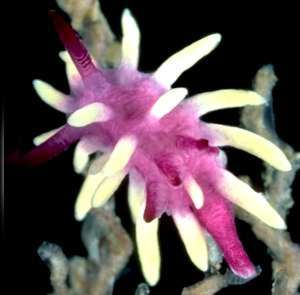
Okenia purpurata
Rudman, 2004
Order: NUDIBRANCHIA
Suborder: DORIDINA
Superfamily: ANADORIDOIDEA
Family: Goniodorididae
DISTRIBUTION
Previously known only from northern New South Wales, eastern Australia. But Toh Chay Hoon's record from Singapore [#22383 ] suggests a wider Indo-West Pacific range.
PHOTO
Upper Right: Split Solitary Is, Coffs Harbour, New South Wales, Australia, on bryozoan, Amathia tortuosa, December 1990, 9 mm long, AM C164523. Photo: W.B. Rudman. Lower Left: SEM of radula. A, part of right side. B, part of left side. Pig Is., Coffs Harbour, New South Wales, Australia, 8 December 1990, AM C164605. Scale bars = 10 µm. Photo: A.C. Miller. Lower Right: Split Solitary Is, Coffs Harbour, New South Wales, Australia, December 1990, 9 mm long, AM C164523. Photo: Bill Rudman.
The body is elongate with a distinct mantle edge bearing 7 cerata-like papillae on each side, which range in length from the relatively short anterior pair to the 4 posterior pairs which are long and cylindrical, tapering to a rounded tip. There is a single mediodorsal papilla about midway between the head and the gills, and a group of 3 or 4 papillae arranged in a transverse line just in front of the gills. In some specimens there is also a small median papilla just behind the gills. There are 4 or 5 long, simple gills. The head bears a pair of rounded and flattened oral tentacles. It grows to at least 11mm long alive. Background colour is pinkish purple, deepening on the rhinophores and gills to a deep reddish purple. The tip of the posterior end of the foot is also deeper in colour. The rounded oral tentacles are a uniform purple. The lateral papillae around the mantle edge are a creamy white or yellow, except for the anterior pair which are a watery purple with a creamy white or yellow tip. The head, foot and sides of body are purple except for a broad translucent cream band at the edge of the foot.
The radula is fairly typical for the Goniodorididae. The innermost tooth has a broad base and a long elongate pointed cusp. At the base of the cusp there are a few [5-6] very small remnant denticles. The innermost tooth also has a large pointed spine arising from the upper inside corner of the base of the tooth. The much smaller outer teeth have a broad quadrangular base with two very large, slightly recurved, pointed cusps
This species has a very distinctive colour pattern. It is very similar in external shape to Okenia vena, and both can be found on the same bryozoan colony. However the colour pattern of the two species is quite different with Okenia purpurata having a purple body and white papillae, while Okenia vena is white all over, with a pattern of brown veins over the dorsal surface. It is usually found on the ctenostome bryozoan Amathia tortuosa Tenison Woods, 1880.
-
Rudman, W.B. (2004) Further species of the opisthobranch genus Okenia (Nudibranchia: Goniodorididae) from the Indo-West Pacific. Zootaxa, 695: 1-70.
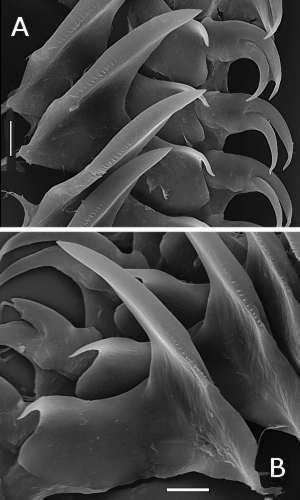
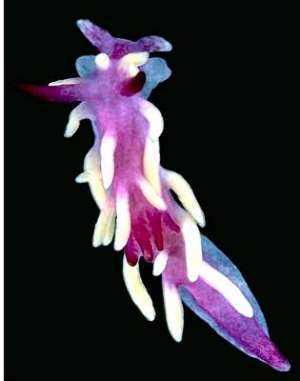
Rudman, W.B., 2004 (December 21) Okenia purpurata Rudman, 2004. [In] Sea Slug Forum. Australian Museum, Sydney. Available from http://www.seaslugforum.net/find/okenpurpurat
Related messages
Re: Okenia purpurata from Singapore with 3 gills?
April 6, 2009
From: Ivan Choong
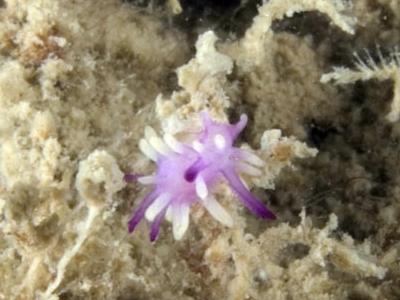
Concerning message #22397:
Dear Dr Rudman,
Please see attached images of Okenia purpurata, hopefully capturing the food source - Amathia tortuosa.
Locality: Island, Pulau Hantu, 12 m, Singapore, Sea, 20 Dec 2008, Silty sea bed. Length: 2 mm. Photographer: Ivan Choong.
Ivan Choong
sales@inscphotography.net
Choong, I., 2009 (Apr 6) Re: Okenia purpurata from Singapore with 3 gills?. [Message in] Sea Slug Forum. Australian Museum, Sydney. Available from http://www.seaslugforum.net/find/22398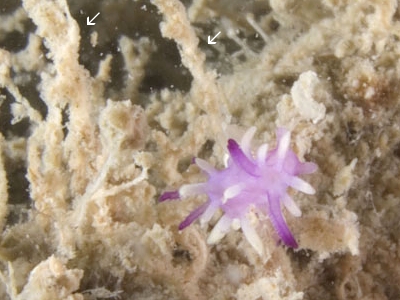
Dear Ivan,
Thanks for the quick reply. It would have been very lucky if you had taken a photo that showed the food bryozoan in detail, but unfortunately not this time. In the photo alongside I have arrowed a couple of possible spirals which could indicate it is eating Amathia tortuosa, but it may just be wishful thinking on my part. Often you we will find animals apparently feeding on unidentifiable bare stalks. All this usually means is that the animals have already eaten all the polyps or zooids. In silty environments like yours, once the animals have died - or been eaten, there is nothing to stop silt and debris from building up over the bare stalks. The characteristic spiral arrangement of the zooids make it possible to identify the remains of an Amathia tortuosa colony in clean water, but I am afraid your silty water quickly hides any identifiable characteristics. Perhaps you can put this on your 'to do' list for when you next encounter this Okenia. In fact a closeup photo of the bryozoan of any Okenia you encounter would be valuable
Best wishes,
Bill Rudman
Re: Okenia purpurata from Singapore with 3 gills?
April 3, 2009
From: Toh Chay Hoon
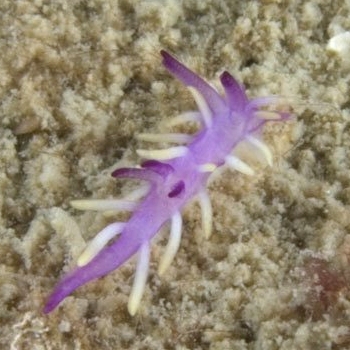
Concerning message #22383:
Dear Dr Bill,
Thanks for the information. Here's another two photos of Okenia purpurata that a friend of mine came across during a dive at Pulau Hantu, Singapore, last December.
Locality: Pulau Hantu, 12 m, Singapore, South China Sea, 20 December 2008, Silty substrates. Length: 2, 5 mm. Photographer: Ivan Choong.
I understand from the factsheet that O. purpurata has 4 or 5 long simple gills. However, his photos show both nudibranch with only 3 gills.
Would like to hear your enlightenment.
Thanks,
Chay Hoon
sonnenflower@gmail.com
Toh, C.H., 2009 (Apr 3) Re: Okenia purpurata from Singapore with 3 gills?. [Message in] Sea Slug Forum. Australian Museum, Sydney. Available from http://www.seaslugforum.net/find/22397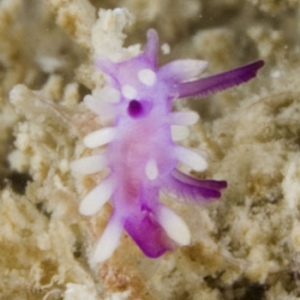
Dear Chay Hoon,
It's nice to get a second record so quickly. Concerning the number of gills. The small size of these animals is the reason as the number of gills increases as the animal grows to maturity. One thing I meant to mention when I replied to your earlier message was whether you saw any sign of its bryozoan food. In Leanne & David Atkinson's earlier message [#19299] there is a good photo of the very characteristic spiral shape of their bryozoan food, Amathia tortuosa, the name tortuosa in recognition of this shape. In the original of Ivan's lower photo, which I have cropped for the Forum, I thought I could see a sign of these spiral stalks. Could you ask him to check his photos to see if he has got a photo which shows this.
I am not sure how specific this species is to a particular bryozoan but it would be nice if it was eating the same species in Singapore. As an added bonus it would also be the first record of the bryozoan outside Australia.
Best wishes,
Bill Rudman
Okenia purpurata from Singapore
April 2, 2009
From: Toh Chay Hoon
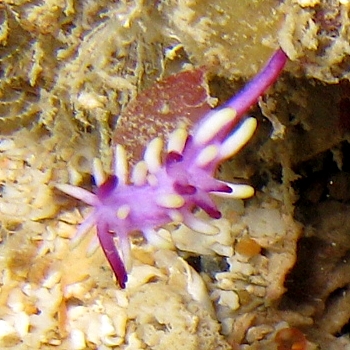
Concerning message #19252:
Dear Dr Bill,
We came across this nudibranch while diving at Pulau Hantu, Singapore.
The nearest ID that I could find on the forum is Okenia purpurata but with a distribution known only from northern New South Wales, eastern Australia.
Locality: Pulau Hantu, 14 m, Singapore, South China Sea, 29 March 2009, Sandy substrate. Length: 10 mm. Photographer: Toh Chay Hoon.
Please kindly advise.
Thanks,
Chay Hoon
sonnenflower@gmail.com
Toh, C.H., 2009 (Apr 2) Okenia purpurata from Singapore. [Message in] Sea Slug Forum. Australian Museum, Sydney. Available from http://www.seaslugforum.net/find/22383Dear Chay Hoon,
This is an interesring discovery. With the proviso that we know nothing of the anatomy of your animal, it is identical in external shape and colour to Okenia purpurata and is almost certainly that species. New South Wales, on the east coast of Australia, has a marine fauna which is an interesting mixture of tropical Indo-West Pacific species, endemic eastern Australian species and southern Australian species. So when we find a 'new' species in New South Wales it is difficult to know just which part of the fauna it belongs to. That's why on the Fact Sheet I have written 'Known only from northern New South Wales, eastern Australia' rather than endemic to New South Wales.
Now, thanks to your find, I will be able to change that to suggest that it probably has a wide Indo-West Pacific distribution. One complicating factor is that it is possible that this species, like some other species of Okenia, is a 'tramp' species travelling the world on the bottom of boats in association with its food bryozoan. I guess we will just have to wait and see where we next get a sighting
Best wishes,
Bill Rudman
A pair of Okenia purpurata
January 23, 2007
From: Leanne & David Atkinson
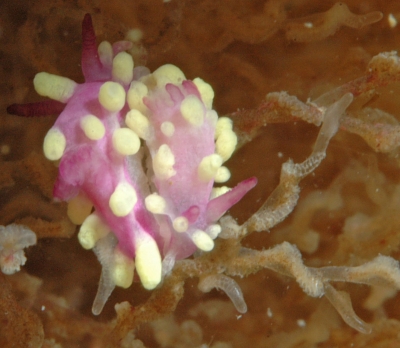
Hi Bill,
The Okenia purpurata and Okenia vena are still at Halifax Sponge Gardens. Here are some photos of Okenia purpurata pairs and an egg mass that was in the Amathia tortuosa. There was quite a few egg masses all at the end of the stalks. It could belong to either nudi or something else I guess. It seemed to be the right size for them.
Locality: Halifax Sponge Gardens,Marine Reserve, Port Stephens, 13 metres, New South Wales, Australia, Pacific, 21 January 2007, Sandy bottom with scattered sponges, ascidians, bryozoans and soft corals. Length: approximately 2 to 3 mm. Photographer: Leanne & David Atkinson.
Regards,
Leanne & David Atkinson
atk@hunterlink.net.au
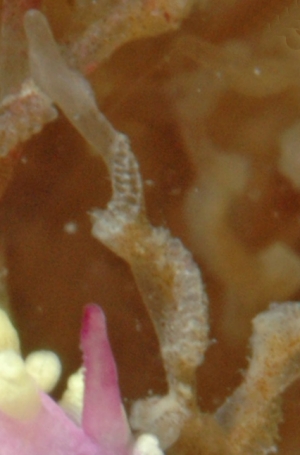
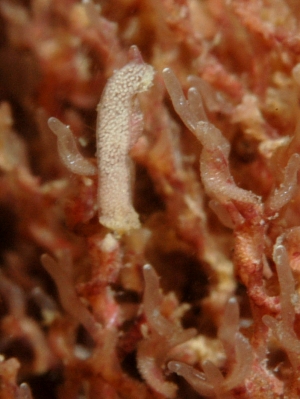
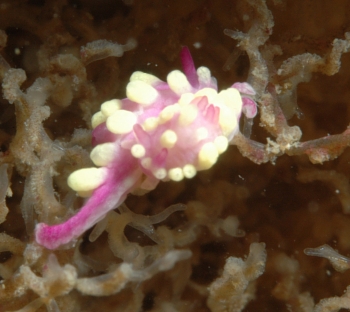
Dear Leanne & David,
I agree that these are most probably the egg masses of one of the Okenia species. I think I have photos of similar egg masses which were associated with the two species. I've included a close-up of the bryozoan as it shows the spiral arrangement of the zooids quite well.
Best wishes,
Bill Rudman
Okenia purpurata from New South Wales
January 18, 2007
From: Leanne & David Atkinson
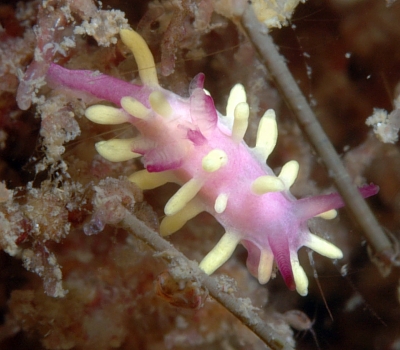
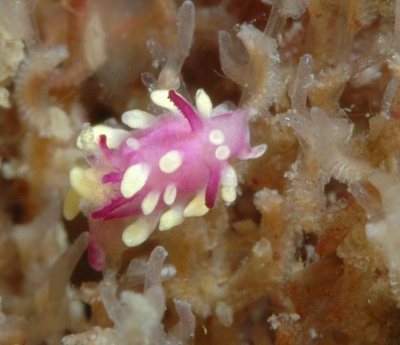
Dear Bill,
Here are some photos of Okenia purpurata we found on Amathia tortuosa with Okenia vena. They are so small they just look like white specks of broken shell until you look closely. These were photographed at 1:1 with a 105 macro lens and are still small in the photo. These ones had cerata with more yellow than white colouring. The ones we found in 2000 had white cerata.
Locality: Halifax Park Sponge Gardens, Marine Reserve, Port Stephens, 16 metres, New South Wales, Australia, Pacific, 13 January 2007, Sandy bottom scattered sponges, soft corals ascidians and bryozoans. Length: approximately 2 to 3 mm . Photographer: Leanne & David Atkinson
One of them seems to have a translucent frill around the foot on the left hand side. We thought it might be eggs but we can't get any individual egg detail when we blow it up.
Regards,
Leanne & David Atkinson
atk@hunterlink.net.au
Atkinson. L. & D., 2007 (Jan 18) Okenia purpurata from New South Wales. [Message in] Sea Slug Forum. Australian Museum, Sydney. Available from http://www.seaslugforum.net/find/19252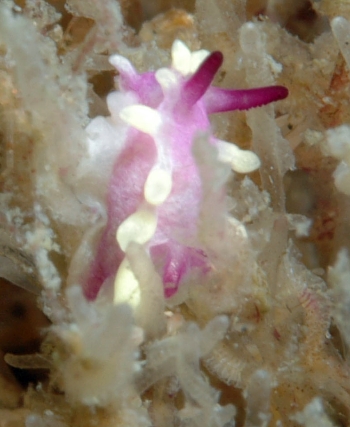
Dear Leanne & David,
Thanks very much for these. I've had a close look at the frill you mention and I am pretty sure it is the edge of the foot.
Best wishes,
Bill Rudman
Okenia purpurata - new record
February 20, 2006
From: L. & D. Atkinson
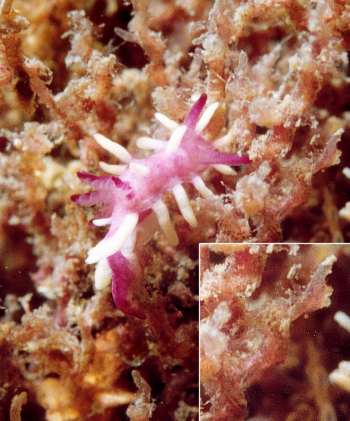
Dear Bill,
After reading your comment on Paul Whitehead's message [#15855] about it being good to get messages on recently described species we thought we'd send these photos of Okenia purpurata. We've only seen them over one spring at Port Stephens. There didn't seem to be any messages attached to the fact sheet.
Locality: The wall, Halifax Sponge Gardens, Marine Reserve, Port Stephens, 10 metres, New South Wales, Australia, Pacific Ocean, 29th October 2000, sand and rock wall covered in sponges, ascidians, bryzoans and hydroids. Length: 3 mm. Photographer: Leanne & David Atkinson.
Regards,
Leanne & David Atkinson
atk@hunterlink.net.au
Atkinson, L. & D., 2006 (Feb 20) Okenia purpurata - new record. [Message in] Sea Slug Forum. Australian Museum, Sydney. Available from http://www.seaslugforum.net/find/15897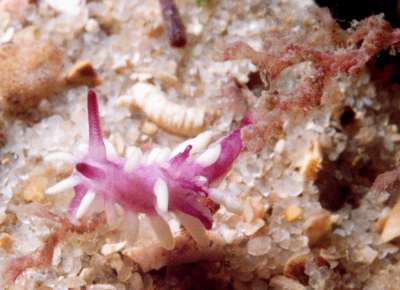
Dear Leanne & David,
Thanks very much. Not only is it nice to have new records of recently described species, but they often help to give us a little more information on their biology. Your message helps confirm my observations on the bryozoan Okenia purpurata feeds on. In both photos it is on the same bryozoan. If you look carefully at the magnified bit [inset] you will see the zooids on the stalk are arranged in spiral groups, which is why this ctenostome bryozoan was given the name Amathia tortuosa.
Best wishes,
Bill Rudman
